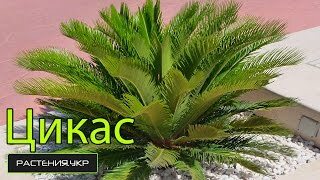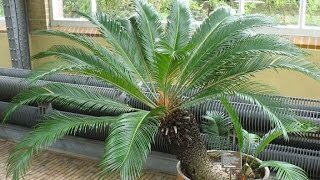Tsikas is preferred to grow by those who philosophically perceive a fast-flowing life. This can be explained by the fact that this representative of the world of flora refers to the oldest group of gymnosperms. They are called living fossils, as cicada appeared on our planet in the Mesozoic era. That is, they witnessed how on Earth the dinosaurs were born, and then the dinosaurs died out. In addition, the cicles are rather slow in growth. At best, throughout the year, a new rosette of leaves may appear at the top, which will last for a couple of years. But at worst - the plant will only release one leaf for a year. Therefore, such growth rates of the cicada set his master on a measured, calm and harmonious rhythm of life.
At one time the cycads( an ancient group of seed plants) occupied a very large territory. Today, approximately 120 species of such a previously numerous family have survived. But at home, only representatives of two genera are grown: Zamia and Tsikas. Their homeland - Australia, the islands of the Indian and Pacific Oceans, Southeast Asia. As a houseplant, the Tsikas of the revolution appears best in South Japan. In appearance it looks like a palm tree, but there is no direct connection between these two plants. Cicas are resistant to pests and diseases. In nature, old specimens reach a height of two meters. The length of the leaves in the natural growth medium is about one meter. But in the room conditions, the dimensions of the cicada are more modest - a maximum of 60-70 cm in height.
Cicada: home care
Cicada: temperature
Cicada needs a temperature of 15-20 degrees. In winter, check that it does not fall below 15 C. Excellent, if the soil temperature is slightly above the ambient temperature.
CYCAS: lighting
Cycas need bright lighting. He feels great in the bright sunlight. But it is better not to "go far" with the sun.
Cicada: irrigation
Watering should be regular, but not abundant. Take care that no water stagnates in the pan. Let the soil dry in periods between waterings, but at the same time, make sure that the soil always remains slightly moist. In winter it is necessary to shorten watering.
Cyqas: air humidity
Humidity needs air like cicada. It should be elevated, so try to spray a short trunk and leathery leaves more often. You can partially wrap the trunk in wet sphagnum moss. But the large leaves are better to wipe with a damp cloth.
Cicada: soil
Soil of cicasa needs weakly acid. A mixture of peat, turf and sand in equal proportions is suitable. The plant also requires good drainage. The top layer of the earth is better not to loosen, otherwise you risk damaging the tender roots.
Cicada: fertilizing with fertilizers
Only organic fertilizers are suitable, because this plant does not tolerate mineral fertilizers. You can feed cicada in summer and spring once a month. Take mullein or horse manure, diluted in water.
Cicada: transplant
Transplant should not be performed every year. Without the special need for such a representative of the world, flora is better not to disturb. Transplant only those specimens that have grown and are already clearly crammed into the pot. For this purpose, the ready-made substrate "palm" is suitable.
Cicada: growing problems
The problems of cultivation are that the reproduction of cicada is difficult at home. Especially if you bought it in the store.
Cicada: yellow leaves, what should I do?
Almost all the owners of cicases are faced with such an unpleasant phenomenon. If the yellow only the tips of the leaves, it means that the room is too dry air or you do not water the plant enough. But if the yellow leaves have turned yellow and dried, then do not worry about that. This is a natural process of growth of cicada and there is no real need to take special measures. Related Videos:
 5:01
5:01  7:18
7:18  1:02
1:02 